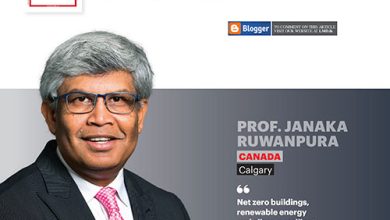SRI LANKA ECONOMIC SUMMIT
THE WAY FORWARD FOR SRI LANKA
Key strategies to drive an economic shift Nirmali Ameresekere reports
With the completion of debt restructuring, the stage is set for Sri Lanka to achieve accelerated growth – provided the right policies are in place to drive and sustain this momentum. Against this backdrop, the Ceylon Chamber of Commerce hosted its flagship event – Sri Lanka Economic Summit – on 28 and 29 January at Shangri-La Colombo.
Under the theme ‘Shaping Sri Lanka’s Future: Transformational Growth Rooted in Sound Economic Policies,’ the summit explored the reforms that need to be implemented to establish an export led investment model.
FUTURE PLANS President Anura Kumara Dissanayake has announced the government’s ambitious target of achieving over four percent growth this year. This goal will be supported by a record allocation of Rs. 1.35 trillion for capital expenditure, marking the highest government investment in recent times.
He also highlighted the need to create a conducive environment for foreign direct investments (FDI) and ensure administrative efficiency. The government plans to streamline the investment approval process, and reduce the timeline from over two years to less than 82 days.
The Board of Investment of Sri Lanka (BOI) will also be reformed to improve its operational efficiency.
Key sectors identified for driving economic growth include tourism, IT and maritime activities. Additionally, major projects in collaboration with India and China are anticipated to bring in substantial foreign investments, which will bolster the country’s economic prospects.
TRANSFORMATION Following two years of contraction, Sri Lanka’s economy has rebounded to pre-crisis levels.
However, LMD columnist and Chief Economic Policy Advisor of the Ceylon Chamber of Commerce Shiran Fernando emphasised that the country needs more than three percent organic growth for businesses to flourish.
Achieving a sustainable growth rate of between five and six percent will require a transformative shift beyond the IMF programme. Looking ahead, a key indicator of progress will be how the country repays its first restructured sovereign bond in 2029 – whether through national reserves or by issuing another bond.
DIGITISATION Chief Advisor to the President on the Digital Economy Dr. Hans Wijayasuriya said that a tight alignment of digital policy with the national economic policy could boost GDP growth by one to two percentage points.
The government’s digital plan for the next five years includes expanding digital exports to US$ 5 billion, increasing the digital workforce to 200,000 and reducing the average transaction cost to below one percent.
Citing the telecom industry as an example, Wijayasuriya emphasised that digital transformation requires a joint effort by the public, private and development sectors, as government investment alone isn’t sufficient.
ROLE MODELS At the heart of South Korea’s economic transformation following the 1997 Asian financial crisis was the private sector, which played a key role in transforming the economy from an import substitution model into export led industrialisation.
Dr. Kyungjin Song – who is the Country Representative of The Asia Foundation in South Korea – stressed that government support and substantial investments in R&D are crucial to the country’s success.
Song noted that despite Sri Lanka’s small population, productivity and competitiveness are key. She highlighted its low tertiary enrolment compared to South Korea where both the state and private sectors actively contribute to human capital development.
Similarly, Senior Manager – Global Trade Advisory of Deloitte Parima Damrithamanij noted that Thailand’s value added export manufacturing journey was built on a comprehensive policy. This included targeted manufacturing support, investment promotion, networking facilitation and resource development.
POLICIES The Chairman of John Keells Holdings Krishan Balendra underscored the importance of policy stability, asserting that frequent shifts in policies due to changes in government or leadership undermine investor confidence.
He suggested that sector specific policies should be maintained for long-term consistency, after securing buy ins from all stakeholder including political parties. While tax reforms are necessary, maintaining a stable tax rate creates a predictable environment for investment.
REFORMS Sri Lanka faces structural obstacles involving inefficiencies in the public sector and state-owned enterprises (SOE). Notably, public sector workers account for a considerable share of the national budget.
Addressing these concerns, Deputy Minister of Finance and Planning Dr. Harshana Suriyapperuma stressed that the issue isn’t whether the government should be involved in business but how efficiently SOEs should operate.
He explained that the government is exploring options to improve SOE efficiency including public-private partnerships (PPP) and potentially privatising certain entities to drive improvement.
Additionally, since a hiring freeze is in effect due to the economic crisis, many institutions face critical staffing gaps, he noted. The government is focussed on repurposing and upskilling existing staff rather than politicising public institutions; it is also seeking assistance from the Ministry of Digital Economy to drive digitisation in the sector, Suriyapperuma revealed.







